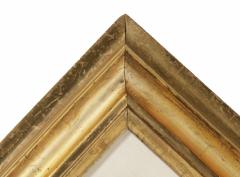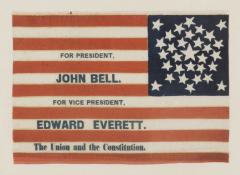31 Stars In Rare Pentagon Medallion, Made For John Bell's Presidential Campaign
-
Description
31 star American parade flag, printed on glazed cotton, made for the 1860 campaign of John Bell and Edward Everett, who ran as independents on the Constitutional Union Party ticket.
The 1850-1865 era marked a pivotal time in American party politics. It bore witness to the birth of the Republican Party in 1854, and the end of both the Whigs and the American Party (Know-Nothings), had basically disappeared by 1860. Lincoln was the Republican candidate, running on the anti-slavery platform. He was hardly the favorite in the beginning of the campaign, winning the party’s nomination from the 3rd ticket.
When the Democrats convened in Charleston in 1860 to nominate a presidential candidate, Douglas succeeded in adding his moderate planks to the party platform. Several Southerners stormed out of the convention, breaking off to form their own party with John Breckinridge and Joseph Lane as their candidates. Northern Democrats met again in Baltimore a few weeks later and unanimously nominated Douglas for president.
The Democratic Party orchestrated their own demise when they split into two factions. John Bell’s Constitutional Union Party, supported by remnants of hard line Whigs and members of the Know-Nothing Party, split the ballot even further. The fractured field resulted in a win for Lincoln, despite the fact that he didn't even appear on the ballot in several Southern States.
Bell garnered more than 12% of the 1860 vote, which constituted one of the highest amounts ever received by an independent party candidate. This effectively remained a record until 1912, when Teddy Roosevelt beat that figure on the Bull Moose ticket, receiving 27.4% to actually edge out former fellow Republican William Howard Taft.
Flags made for Bell’s campaign are very scarce. The slogan itself is more significant than some others because of the fact that modern day Americans can connect with it. It speaks not only to the hopeful avoidance of the impending Civil War, but to our nation’s founding principles. Simply put, the presence of the words “Union” and “Constitution” on an early Stars & Stripes flag contributes a lot to desirability.
Note how the stars are arranged in a very interesting medallion pattern that, instead of being circular or star shaped, forms a pentagon. A few variations of the rare pentagon pattern are known and all are peculiar. Note that there is a star in each corner of the canton, which is typical of medallion designs, but there is also a single star at the very bottom center, which almost transforms the pentagon into an acorn.
A similar star formation, with the same rough-cut stars, appears on a flag submitted for copyright by H.C. Howard on July 12, 1860 to the Philadelphia courthouse. In his rush to get as many copyrights as possible, he actually combined two designs in one patent, including a written description of a Douglas with 33 stars across an image of a 31 star flag. He copyrighted several flags for all four candidates in July of 1860, just after the national conventions.
Note that 31 is two stars short of the official star count in 1860. This is sometimes the case with political campaign flags, which often have a number of stars that is one or more behind what was official in the election year. Sometimes campaigning may have started before the election year. At other times the star count probably wasn’t that important to the person ordering these small, printed flags. The purchaser might have frequently been the campaign manager, but may sometimes have been a private individual who supported the candidate politically and wanted to make a classy display at his/her home or business along the campaign route.
Flags made prior to the Civil War are extremely rare, comprising less than one percent of 19th century flags that have survived to present-day America. Prior to the Confederate attack on Fort Sumter, the Stars & Stripes was simply not used for most of the same purposes we employ it in today. Private individuals did not typically display the flag in their yards and on their porches. Parade flags didn't often fly from carriages and horses. Places of business rarely hung flags in their windows. Private use of the national flag rose swiftly during the patriotism that accompanied the Civil War, then exploded in 1876.
Even the military did not use the flag in a manner that most people might think. Most people would be surprised to learn that the infantry wasn’t authorized to carry the Stars & Stripes until the 1830’s, and even then did not often exercise the right, because it was neither required nor customary. The primary purpose before the Mexican War (1846-48) was to mark ships on the open seas. While the flag was used to mark garrisons and government buildings, the flags of ground troops were often limited to the flag of their own regiment and a federal standard.
Don’t be fooled by the flag’s seemingly backwards orientation. The flag ethics that we have today did not emerge until the turn-of-the-century, so before this time there was no backwards or forwards.
This particular parade flag was at one time sewn into a quilt that consisted of many rare political flags. Many years ago these were deconstructed and the flags were individually sold because of their great value. Some of the original stitching that joined the flag within the quilt is present along the top edge.
Biographical Information on John Bell & Edward Everett:
John Bell was born near Nashville, Tennessee in 1797. A 1814 graduate of the University of Tennessee, Bell passed the bar in 1816 and set up a law practice in Franklin. He was elected to the Tennessee State Senate just one year later, in 1817, then declined re-election. He became a U.S. Congressman in 1827, serving 7 terms. During this time he served as Speaker of the House, chairman of the Committee on Indian Affairs, and chairman of the Committee on Judiciary. He served a very brief term as Secretary of War in 1841. In 1847 he was elected to the Tennessee State Congress, and in the same year became a U.S. senator (Whig Party), serving nine years before his run for the presidency. The Constitutional Union ticket carried just three states, Tennessee, Kentucky, and Virginia. Bell died at his home in 1869, near Chattanooga, and is buried near Nashville.
Born in Boston in 1794, Edward Everett studied abroad in Germany and returned to the U.S. as the first American to ever receive a Ph.D. He was Governor of Massachusetts (1836-40), President of Harvard (1846-49), and Secretary of State (1852-56) under Millard Fillmore, following the death of his friend Daniel Webster. Everett was considered the greatest orator of the time, which is why he was selected to give a speech at Gettysburg in 1863, to dedicate the memorial to fallen soldiers. He spoke for two hours, but Americans will forever remember the day, not for Everett, but for Abraham Lincoln, who was asked to follow with a “few appropriate remarks”. These became the Gettysburg Address. Everett died in Boston in 1865 and was interred in Mount Auburn Cemetery, Cambridge.
Election Results: Abraham Lincoln, Illinois (R) - 39.8% (PV), 180 (EV), Stephen Douglas, Illinois (Northern D) - 21.5% (PV), 12 (EV), John C. Breckinridge, Kentucky (Southern D) - 14.3% (PV), 72 (EV), John Bell, Tennessee (Constitutional Union) - 12.6% (PV), 39 (EV)
Mounting: The flag has been hand-stitched to a background of 100% hemp fabric. The mount was then placed in a gilded molding that dates to the period between 1830 and 1860. Spacers keep the textile away from the glazing, which is U.V. protective glass.
Condition: There is a tiny stain at the top above the first red stripe. A portion of the last red stripe wasn't trimmed in a straight line. Period parade flag fabric with matching coloration was placed behind this area to mask the loss. The overall condition is excellent. -
More Information
Origin: United States, California Period: 19th Century Condition: Excellent. See Item Descriptoin Creation Date: 1860 Styles / Movements: Americana Dealer Reference #: 31j-840 Incollect Reference #: 140898 -
Dimensions
W. 21.25 in; H. 17.5 in; W. 53.98 cm; H. 44.45 cm;
Sold





















